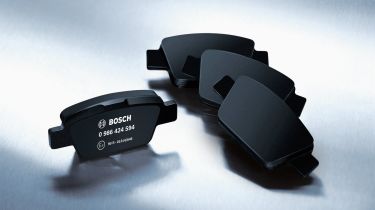How to check brake pads
Healthy brake pads are key to the safety of your car. We explain what they do and how to check them

Brakes are the only thing that will stop your car – but how often do you think about checking them? You should, because they’re subject to huge forces, they can wear out pretty quickly.
You may not wish to carry out any maintenance work yourself but even so, it pays to know how your brakes work so that you know, for example, what brake pads are and how crucial they are to your safety. It’s the same reason you should be aware of the basic points of car maintenance.
We guide you through everything you need to know, below.
What are brake pads?
These are small highly resistant pads of material that are located on either side of each of the car’s brake discs. Look through each wheel and you’ll see the brake discs. Like the wheels, they are attached to the axles, so braking them stops the axles turning.
• What is autonomous emergency braking?
Holding the pads against the discs are things called brake calipers. They have pistons in them that are pushed out by fluid as you press the brake pedal. As they move out, they cause the pads to press against the brake discs. The harder you push the pedal, the tighter they squeeze.
What do my brake pads do?
Depending how heavily you brake, the pads wear out at around 30,000 miles and must be replaced. The discs, especially the front pair which take most of the strain, also wear out from the pads rubbing against them and are spent by around 60,000 miles.
The pads wear because when they grip the discs they get very hot. Even though they’re tough, they can't be any tougher than the discs they act on. This is why they’re made of fire-resistant material (not asbestos) which, although tough, does wear down in time. Once they are worn down, the pads become much less efficient at dissipating heat and resisting wear, and your car’s braking power suffers.
Why do my brake pads need checking?
Your brake pads are made from very tough material, but they have an extremely tough job to perform and won’t last forever. Why is that?
Are you ready for a science lesson? No? Well, here we go anyway. A fast-moving car is heavy and has a huge amount of kinetic energy. The only way to slow it down is to get rid of some of that energy – that’s the job of the brakes. Energy can’t just be lost, though; it has to be transferred.
When the brake pads apply force on the rapidly spinning brake discs, the discs and pads both get very hot. This is because a lot of the kinetic energy is converted to heat energy. There are other energy transfers taking place, too – braking isn’t silent, so there’s noise (acoustic energy) being released. Of course, with such huge forces involved, the brake material itself takes a hammering. Hence the pads will gradually wear thin as the discs rub against them.
Brake pads are extremely tough, but in order to dissipate such a huge amount of energy they have to be made from a material that’s slightly less resilient than the hardened steel of the discs. They used to be made from asbestos, but are now usually made from less toxic materials with similar properties.
Eventually the brake pads will have worked so hard that their expendable material has all been ground or burnt away, and it’s time for replacement. Remember, without brake pads, there’s nothing to grab hold of your brake discs and stop your wheels from turning.
How do I check my brake pads?
Many cars will have a brake pad wear sensor that causes a warning to illuminate on the dashboard once the pads reach a certain level of wear. However, not all cars have this system and it’s not always entirely reliable when it is present.
The pad wear warning light relies on the brake material between two electrical contacts wearing away, causing the contacts to touch and the circuit to be completed. Assuming the brake pads have worn evenly, this system should work. But if the area of pad between the two contacts remains intact even though the surrounding area has worn away, you won’t get a warning on the dashboard.
In some cases, you used to be able to hear when your pads were wearing thin – towards the end of their life, the pads would make a high-pitched squeal when the brakes were applied. However, a similar noise could also be caused by contaminated brake surfaces, low-quality or poorly installed pads. Noise alone is no longer a reliable indicator of brake condition.
In the vast majority of cases, you may be able to see your brake discs and calipers between the spokes of your wheels, but you won’t have enough access to perform any meaningful measurement. Even if you can measure the pads you can see, the ones on the inside of the disc will be obscured – and these may be more worn than the outer pads.
Therefore, accurately checking your brake pads in most cases involves removing the wheels of your car. This isn’t a task we recommend you do unless you have accurate instructions to follow for your specific car and access to safe workshop conditions and the correct tools for the job. If you do remove your wheels, ensure the car is supported safely on suitable axle-stands, following the instructions of its manufacturer. Never work on a car supported by a jack alone.
All good suppliers of motoring tools will be able to sell you a set of brake-pad measuring slides, which work in a similar way to feeler gauges. You insert them against the brake pads in the gap between the brake caliper and the surface of the disc. The thickest slide that’ll fit the gap equates to the thickness of brake pad remaining. But this information alone is of little use unless you know the minimum required thickness of brake pad the manufacturer recommends for your car – and this information can be difficult to get your hands on.
In many cases, though, there’ll be a wear indicator cast or moulded into the brake pad material itself. This appears as a line or notch on either end face of the brake pad. It’s not always easy to see, though – and it’s easily possible for the pads to become worn past the indicator.
What clues are there that my brake pads need replacing
Although noise alone isn’t always an accurate indicator of brake wear, if your brakes suddenly begin to make a different noise than you’re used to, this could be a sign that something isn’t right. Most notably, if brakes begin to make a dull grinding noise, this can indicate that the brakes pads are worn away completely and you’re hearing the metal parts of the brake calipers themselves contacting the brake discs.
In this case, you’ll almost certainly notice a decrease in braking performance, and if you ever find your brakes less effective than they used to be, your pads and discs should be checked.
Similarly, if you notice the brakes feel different to normal, or that the car judders or pulls to one side when you apply the brakes, your braking system will certainly need attention.
How expensive are brake pads?
The good news is that the brake pads are the least expensive part of your braking system to replace. In many cases, a garage will charge more for the hour or so of labour that changing pads takes than for the parts themselves.
Excluding labour, the cost of the brake pads will, of course, vary from car to car. On a small hatchback, you can expect them to cost significantly less than a tank of petrol. However, if your car has a high-performance braking system, or especially hi-tech carbon-fibre or ceramic brakes, a set of pads can cost many hundreds of pounds.
Original or aftermarket brake pads?
There are many different types available for most cars. The original equipment manufacturer (OEM) parts fitted by the factory will have been developed for an optimised compromise between cost, performance and longevity, while those bought from aftermarket suppliers could meet a very different specification.
We advise sticking with the parts the manufacturer intended, particularly if you’re changing the brake pads only while retaining the original brake discs. Some ‘high-performance’ brake pads will indeed slow the car down more rapidly, but this may come at the expense of longevity, quietness or smoothness of operation.
How can I make my brake pads last longer?
Learning to drive smoothly is probably the best thing any motorist can do, and saving money is its chief benefit.
Many of us hit the brakes when we really don’t need to, and every time we do this it takes material away from our brake pads. Have you ever followed another motorist and watched their brake lights come on at strangely frequent intervals? Braking unnecessarily is an expensive waste of time and effort.
By learning to moderate your accelerator input, you can actually save money twofold. Firstly by saving petrol through not accelerating unduly hard and secondly by saving your brakes from scrubbing off unnecessary speed. The same thing goes for when you’re cruising along. If you sit at a safe distance from the vehicle in front, you won’t need to keep braking and accelerating to match its speed.
What are anti-lock brakes (ABS)?
If you imagine your car to be attached to the car in front by a bungee cord, you can keep a safe distance from it without having to accelerate and brake rashly. Your car will lose momentum naturally, without the brakes being applied. Keeping a sensible distance from the car in front will ensure you never have so little space that you’re forced to apply the brakes.
Of course, you can’t make a journey without using the brakes at all, but you’ll be surprised at how little you actually need to use them if you exercise a little care and forward planning.
For more insight on keeping your car looked after, check out our article on the 10 secrets of DIY maintenance.
Most Popular

New Smart #5 Brabus is a 637bhp far cry from the brand’s city car past

Best car leasing deals 2025: this week’s top PCH offers
Tips & advice

Car dashboard warning lights: what does each symbol mean?

Electric car charging stations: public networks, charger types, apps and maps







